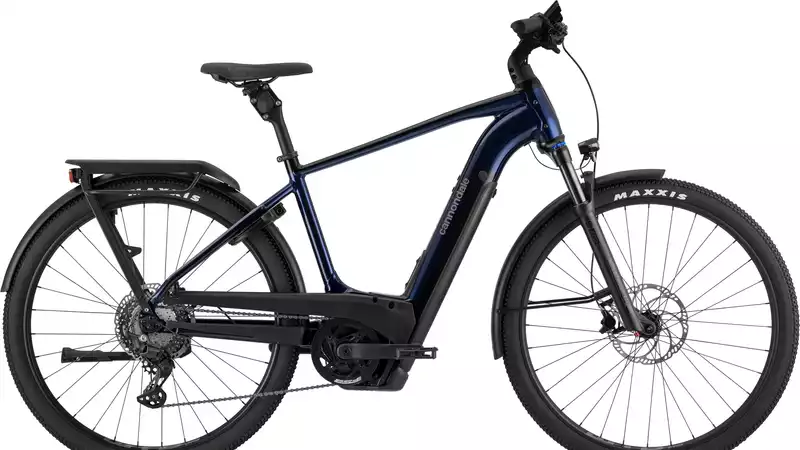Cannondale, known for its road and mountain bike performance, boasts innovative technology and has been quietly building new versions of its Mavaro Neo and Tesoro Neo X electric bikes. Targeted at the urban and commuter markets, these bikes share many similarities, but there are some key differences that suggest subtle differences in functionality.
Whether you're commuting to work, grabbing a coffee, or heading out into the countryside through poorly maintained roads and the occasional railing, Cannondale seems to have an electric bike to meet your needs. A number of innovative new technologies have been introduced, and the quality expected from the brand seems to be well integrated, especially in models that have evolved since 2015/16.
While some bike technologies evolve at Darwinian speeds, when it comes to the best electric bikes, their internals seem to be improving by the minute. The Mavaro Neo and Tesoro Neo X are no different in this regard, with both featuring upgraded 750 Wh batteries and a range of up to 175 km on a single charge (in most cases). The previous Mavaro Neo series had the ubiquitous large external battery, but now the 2020 Tesoro Neo X (and many other e-bikes) have caught up, with the battery neatly integrated into the downtube for a much improvements.
While the changes to the Tesoro Neo X are more subtle, Cannondale has added a third semi-dropped top tube model to complement the step-through and standard high top tube frame design and to address a wider range of needs. The integrated bi-lock, previously only available on the Tesoro Neo X step-through model, is now also available on all three new models.
All of these new electric bikes were designed with practicality in mind. Both have integrated racks for carrying CO2 cartridges and more than a few levers, integrated lighting for getting home after a long day at the office, and moderate suspension to cushion even the most poorly maintained roads.
Both the Mavaro Neo and Tesoro Neo X are fun to ride around town, but they are sisters rather than twins; the Mavaro Neo is designed to perform best on paved surfaces and is more of a thoroughbred commuter e-bike. Gates belt drive and hub gears allow for maintenance-free riding all day, every day, and a large Lezyne headlight plus a daytime running light make safety a priority throughout the day. The vehicle is also equipped with a rearward radar, developed in conjunction with Garmin, to ensure traffic safety.
The Tesoro Neo X also has daylight running lights, but uses a more standard chain and derailleur drivetrain with a wider range and lower gears. This, combined with wider, slightly knobbier tires and twice the suspension travel of the Mavaro (100 mm instead of 50 mm), suggests the possibility of going out into the countryside and off-roading when one gets tired of the bright lights of the big city.
Urban-focused bikes, especially electric bikes, have been at the forefront of technology integration for some time now because of their large power capacity. Huge batteries make it easy to incorporate integrated lighting without resorting to expensive dynamo hubs, and the Mavaro Neo and Tesoro Neo X have improved on this concept by equipping the headtube with an always-on lighting strip. On most e-bikes there is little risk of forgetting to charge the lights, but in this case there is always a backup even if the rider forgets to switch on the main beam.
Both models have other different but equally good technical integration. The Tesoro Neo X and Mavaro Neo have a stem with an integrated cell phone mount for easy navigation on long trips. However, the bike does not have the ability to charge the cell phone, which may limit the cell phone's battery life more than the motor.
The Mavaro Neo has a radar built into the rear carrier similar to the new Synapse. While it is unlikely that one would mistake the Synapse for the Mavaro, it is reassuring to know that Cannondale is serious about the safety of all road riders, whether they are performance or utility oriented.
Advances in geometry and design have been focused primarily on the performance end of the market: road, gravel, and MTB. It is rare to have the opportunity to sing and dance about interesting developments in commuter bike geometry, but in the case of these new models, there is something to shout about.
In short, as the bike gets smaller, the front wheel gets progressively closer to the downtube and the rider's feet, increasing the risk of toe contact with the tire. The easiest way to combat this is to loosen the angle of the head tube, but doing so slows the bike down and makes it feel lackluster. Cannondale instead designed its smallest frames with a 27.5-inch wheel size instead of 700c.
If you want a standard top-tube Mavaro Neo model, it costs £5,800 ($7,770). The step-through version is the same price-wise, but in a rather stunning shade of candy red in addition to the ubiquitous black.
The Tesoro Neo X costs 5,000 pounds ($6,700) for all models and is available in "charcoal gray" in all three frame shapes. The step-through frame is available in "Lavender," the drop top tube in light green ("Agave"), and the standard top tube in dark blue ("Midnight").
Interested in e-bikes in general' There is a comprehensive guide that covers everything you need to know about electric bikes.
.

Comments